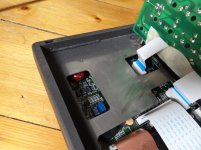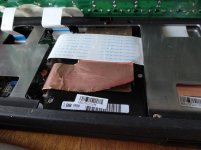Wow, this thread really took off now.  I'd like to use the battery that is simplest to install, of course. There should be enough room (I'll check in a bit).
I'd like to use the battery that is simplest to install, of course. There should be enough room (I'll check in a bit).
I got the computer up and running today, without any issues. It's running happily as I write this. The screen is terrible of course, so I hooked it up to a CRT monitor. Without a working battery, it can't find its hard drive, so I booted it up from a Windows 98 boot disk.
The screen is terrible of course, so I hooked it up to a CRT monitor. Without a working battery, it can't find its hard drive, so I booted it up from a Windows 98 boot disk.

Here it is running Commander Keen 4 on the built in screen:

I wonder how I'm supposed to turn this thing off. The power switch only has on and standby, which doesn't do anything. The only solution right now is pulling out the power cable.
This is where the battery sits. There's about half an inch (1,3 cm) of space between the motherboard and the plastic above it.

I got the computer up and running today, without any issues. It's running happily as I write this.

Here it is running Commander Keen 4 on the built in screen:

I wonder how I'm supposed to turn this thing off. The power switch only has on and standby, which doesn't do anything. The only solution right now is pulling out the power cable.
This is where the battery sits. There's about half an inch (1,3 cm) of space between the motherboard and the plastic above it.

Last edited:

